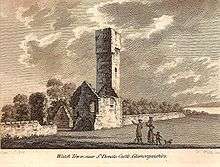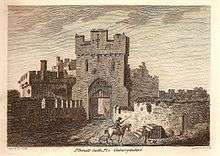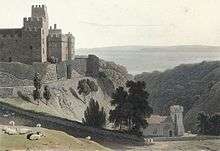St Donat's Castle

St Donat's Castle (Welsh: Castell Sain Dunwyd) is a medieval castle in the Vale of Glamorgan, Wales, overlooking the Bristol Channel in the village of St Donat's near Llantwit Major, and about 25 km west of Cardiff. Since 1962 the castle has housed an international secondary school called Atlantic College.
The castle lies on an elevation to the east of a small valley opening to the sea between precipitous sea cliffs to both east and west.
An inner court about 40 m across within a polygonal inner curtain wall is closely surrounded by an outer court and curtain wall with a dry moat facing the eastern approach. The curtain walls date from c. 1300, having been built by the founder of the Stradling family (or perhaps by his widow's second husband). The outer wall mostly survives and has a small original tower entirely contained with it on the north, and a square gatehouse on the east. The inner court is entered by an arch on the east side beside the rectangular Mansell Tower (an enlargement of the original keep). The northwestern range is of the early 16th century; the northeastern range is of the late 15th century; the late 15th-century great hall is on the south side of the court.

Beside it, squeezed in between the inner and outer curtain walls, is the Bradenstoke Hall, consisting of the inner curtain wall on the north side, the somewhat realigned outer curtain wall on the south, with a modern wall on the east end built at the point so that an early-14th-century roof (brought from Bradenstoke Abbey in Wiltshire) would fit. The western range has largely been replaced by a much larger, three-storey building (which necessitated, when erected, the demolition of the western part of the outer curtain wall). Its ground floor is a large modern dining hall with a very fine 15th-century roof, probably Flemish in origin but imported from Boston Stump Church (Lincolnshire). The Lady Anne Tower on the southwestern corner of the castle has been rebuilt many times.
Ownership

The earliest surviving parts of the castle (the keep and what is now the inner curtain wall) were built in the late 12th century by the de Hawey family. Ownership passed to the Stradling family in 1298 through the marriage of Sir Peter Stradling to Joan de Hawey. The Stradlings built the outer gatehouse and curtain wall around 1300; they enlarged the keep and inner gatehouse and modified the inner curtain wall at the same time, and built the inner court around 200 years later.
The Stradling family (which included a notable recusant, a well-known antiquary and a Latin poet) owned St Donat's Castle until the death of Sir Thomas Stradling in 1738, when ownership of the castle passed to Sir John Tyrwhitt. Archbishop James Ussher resided there for a time during the Civil War. Thereafter, the castle fell into a state of disrepair. Partial restoration was started by Dr John Whitlock Nicholl Carne, who claimed to be descended from the Stradlings, and had bought the castle from the Tyrwhitt-Drake family in 1862. Morgan Williams, the owner from 1901 to 1909, carried out extensive and careful restoration. Godfrey Williams, Morgan's son, sold the castle to Richard Pennoyer, an American, in 1922.
After seeing photographs of the castle in Country Life magazine, the newspaper magnate William Randolph Hearst bought it in 1925. Hearst spent a fortune renovating and revitalising the castle with architectural trophies from across the country,[1] and bringing electricity not only there but also to the surrounding area.[2] The locals enjoyed having Hearst in residence at the castle; he paid his employees very well, and his arrivals always created a big stir in a community not used to American excesses. Hearst spent much of his time entertaining influential people on his estate. He was renowned for holding lavish parties at St Donat's; guests included Charlie Chaplin, Douglas Fairbanks, and a young John F. Kennedy. Upon visiting St Donat's, George Bernard Shaw was quoted as saying: "This is what God would have built if he had had the money."
Hearst's newspaper empire fell on hard times in the later 1930s; the castle was put up for sale but requisitioned for use by British and American troops during World War II. Hearst died in 1951 and the castle was bought in 1962 by Monsieur Antonin Besse II (1927– ), son of the late Sir Antonin Besse (1877–1951), and given to the Governing Body of Atlantic College. Monsieur Antonin Besse II is a patron and honorary vice-president of the United World Colleges.
Residential sixth-form college

The castle now houses Atlantic College, an international sixth-form College founded in 1962 as the first of the 16 United World Colleges.
St Donat's Arts Centre
Within the castle grounds lies St Donat's Arts Centre, housed in a 14th-century tithe barn which has been converted to a professionally equipped theatre, together with a contrasting new addition of the Glass Room. This offers views across the sea towards Exmoor. The centre provides a programme of cinema, exhibitions, festivals and live shows.
See also
References
- ↑ J Mordaunt Crook, 2014, "High Ceilings Before the Fall", Times Literary Supplement 9 May 2014 p 10
- ↑ Bevan, Nathan (3 August 2008). "Lydia Hearst is queen of the castle". Wales on Sunday. Retrieved 2008-08-03.
Further reading
- St Donat's Castle – a guide and brief history, Alan Hall, Atlantic College, 2002
External links
| Wikimedia Commons has media related to St Donats Castle. |
- St Donat's Arts Centre website
- A History of the St Donat's Castle
- The Stradling Family
- www.geograph.co.uk : photos of St Donat's Castle and surrounding area
Coordinates: 51°24′6.65″N 3°32′0.04″W / 51.4018472°N 3.5333444°W